Brake Caliper Inspection Rear
Special Tools
J 23738-A
Hand Vacuum Pump
- Inspect the brake fluid level in the brake master cylinder reservoir.
Warning: Refer to Brake Fluid Irritant Warning in the Preface section.
Caution: Refer to Brake Fluid Effects on Paint and Electrical Components Caution in the Preface section.
Note: Do not completely empty the brake master cylinder reservoir.
Note: The brake fluid level must be midway between the maximum
brake fluid level marking and the minimum brake fluid level marking.
- If required, use
J 23738-A
to
remove some brake fluid until the brake fluid level is midway between the maximum
brake fluid level marking and the minimum brake fluid level marking.
Warning: Refer to Safety Glasses Warning in the Preface section.
Danger: To avoid any vehicle damage, serious personal injury or death when major components are removed from the vehicle and the vehicle is supported by a hoist, support the vehicle with jack stands at the
opposite end from which the components are being removed and strap the vehicle to the hoist.
- Raise and support the vehicle. Refer to
Lifting and Jacking the Vehicle.
- Remove the rear wheel. Refer to
Tire and Wheel Removal and Installation in Tires and Wheels.
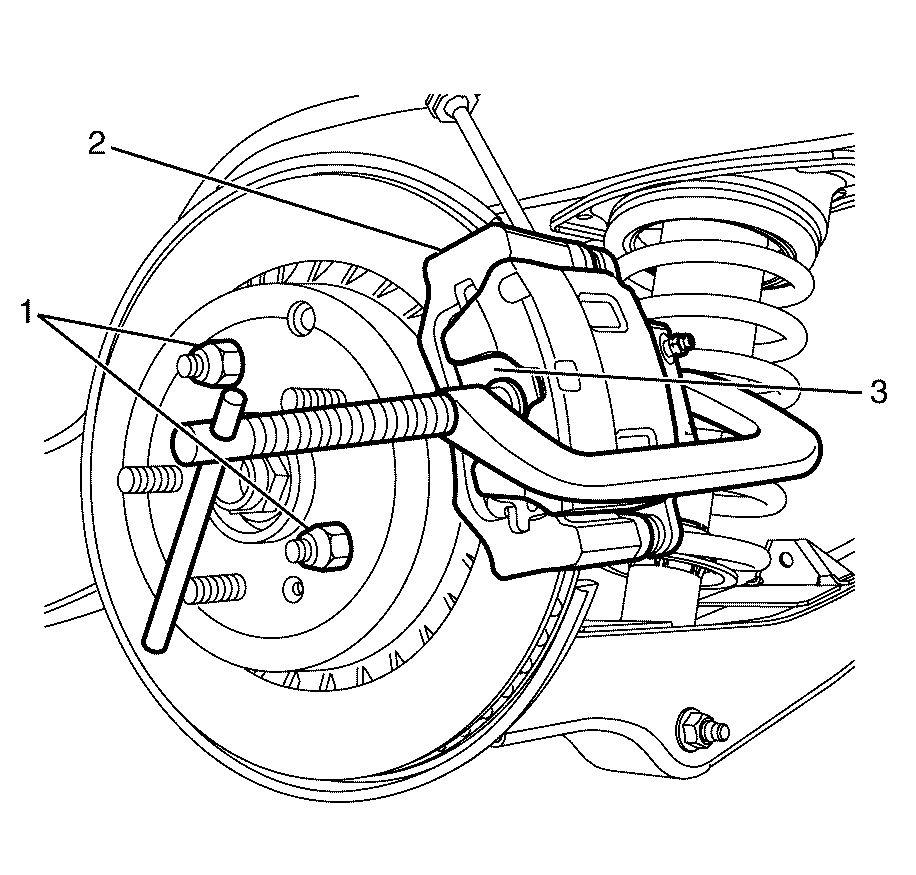
- Install two wheel nuts (1) with the
flat side of the wheel nut against the brake rotor to retain the brake rotor to the
wheel hub.
Warning: Refer to Brake Dust Warning in the Preface section.
Note: Position the ends of the G-clamp against the rear of
the brake caliper (2) and against the outboard brake pad (3).
- Install a large G-clamp over the body of the brake caliper (2).
Note: The brake caliper pistons should slide smoothly into
the brake caliper bores. Overhaul or replace the brake caliper assembly if the brake
caliper piston is frozen or the brake caliper piston does not bottom out smoothly.
- Tighten the G-clamp until the brake caliper piston bottoms out in the brake
caliper bore.
- Remove the G-clamp from the brake caliper (2).
Note: Minimal freeplay should exist between the brake caliper (2)
and the anchor bracket. If too much free play exists, the brake caliper guide pins
and anchor bracket requires further inspection.
- Grasp the brake caliper (2) and move the brake caliper (2) up
and down.
Note: The brake caliper (2) should slide smoothly
along the brake caliper guide pins with minimal force. If the movement of the brake
caliper (2) along the guide pins are not smooth, the brake caliper guide pins
and anchor bracket requires further inspection.
- Grasp the brake caliper (2) and move the brake caliper (2) in
and out along the brake caliper guide pins.
Note: DO NOT disconnect the hydraulic brake flexible hose
from the brake caliper. Failure to comply will require that the brake system be bleed.
- Remove the brake caliper. Refer to
Rear Brake Caliper Replacement.
Caution: Support the brake caliper with heavy mechanic wire, or equivalent, whenever it is separated from its mount and the hydraulic flexible brake hose is still connected. Failure to support the caliper
in this manner will cause the flexible brake hose to bear the weight of the caliper, which may cause damage to the brake hose and in turn may cause a brake fluid leak.
- Inspect the brake caliper to knuckle retaining bolts for the following:
| • | Seizing in the knuckle. |
- If any of the conditions listed above are found, replace the brake caliper
to knuckle retaining bolts.
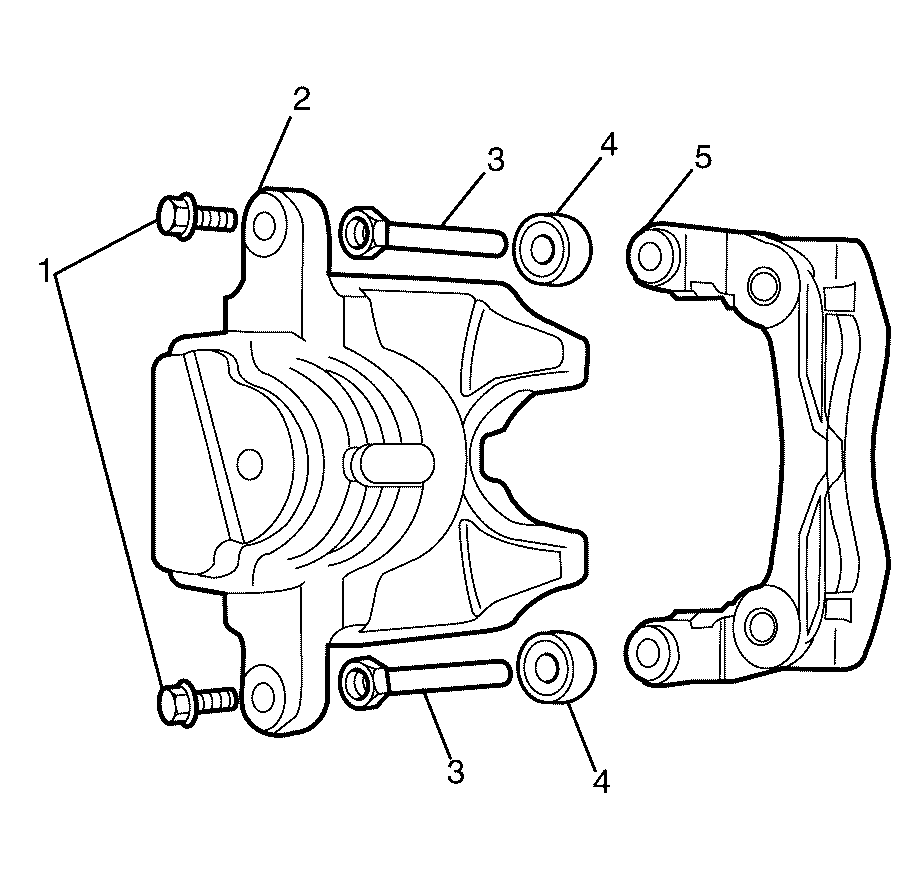
- Remove the brake caliper lower guide pin
retaining bolts (1) and inspect for the following:
- If any of the above conditions are found, replace the brake caliper lower
guide pin retaining bolts (1)
Note: Do not disengaging the guide pins from the brake caliper
boots (4) at this stage.
- Gently slide the brake caliper guide pins (3) in and out of the anchor
bracket (5) and inspect brake caliper guide pins (3) for the following:
- If any of the conditions listed above are found, replace the brake caliper
guide pins (3).
- Inspect the brake caliper boots (4) for the following:
| • | Missing brake caliper boots (4). |
| • | Cracked or torn brake caliper boots (4). |
- If any of the conditions listed above are found, replace the brake caliper
boots (4).
- Inspect the brake caliper (2) and brake caliper anchor plate (5)
for the following:
| • | Bent or damaged brake caliper anchor plate (5). |
| • | Excessive play between the brake caliper guide pins (3) and the
brake caliper anchor plate (5). |
| • | Excessive play between the brake caliper guide pin bolts (1) and
the brake caliper (2). |
- If any of the conditions listed above are found, replace or overhaul the
brake caliper assembly.
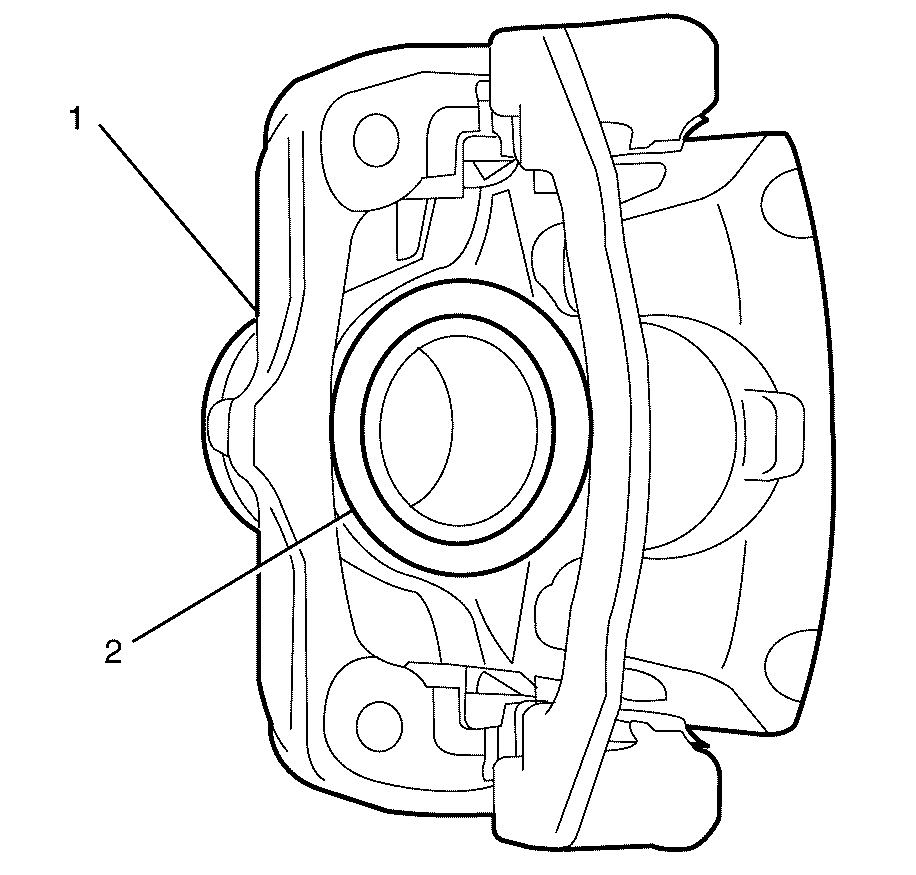
- Inspect the brake caliper piston dust boot
seals (2) for the following:
| • | incorrect seating of the brake caliper piston dust boot seals (2)
in the brake caliper (1) |
| • | brake fluid leakage around the brake caliper piston dust boot seals (2) |
- If any of the conditions listed above are found, replace or overhaul the
brake caliper assembly.
Brake Caliper Inspection Front Base and GT
Tools Required
J 23738-A
Hand Vacuum Pump
- Inspect the brake fluid level in the brake master cylinder reservoir.
Caution: Refer to Brake Fluid Effects on Paint and Electrical Components Caution in the Preface section.
Warning: Refer to Brake Fluid Irritant Warning in the Preface section.
Note: Do not completely empty the brake master cylinder reservoir.
Failure to comply will require a complete bleeding procedure of the braking system.
Note: The brake fluid level must be midway between the maximum
brake fluid level marking and the minimum brake fluid level marking.
- If required, use
J 23738-A
to
remove some brake fluid until the brake fluid level is midway between the maximum
brake fluid level marking and the minimum brake fluid level marking.
Warning: Refer to Safety Glasses Warning in the Preface section.
Danger: To avoid any vehicle damage, serious personal injury or death when major components are removed from the vehicle and the vehicle is supported by a hoist, support the vehicle with jack stands at the
opposite end from which the components are being removed and strap the vehicle to the hoist.
- Raise and support the vehicle. Refer to
Lifting and Jacking the Vehicle.
- Remove the front wheels. Refer to
Tire and Wheel Removal and Installation.
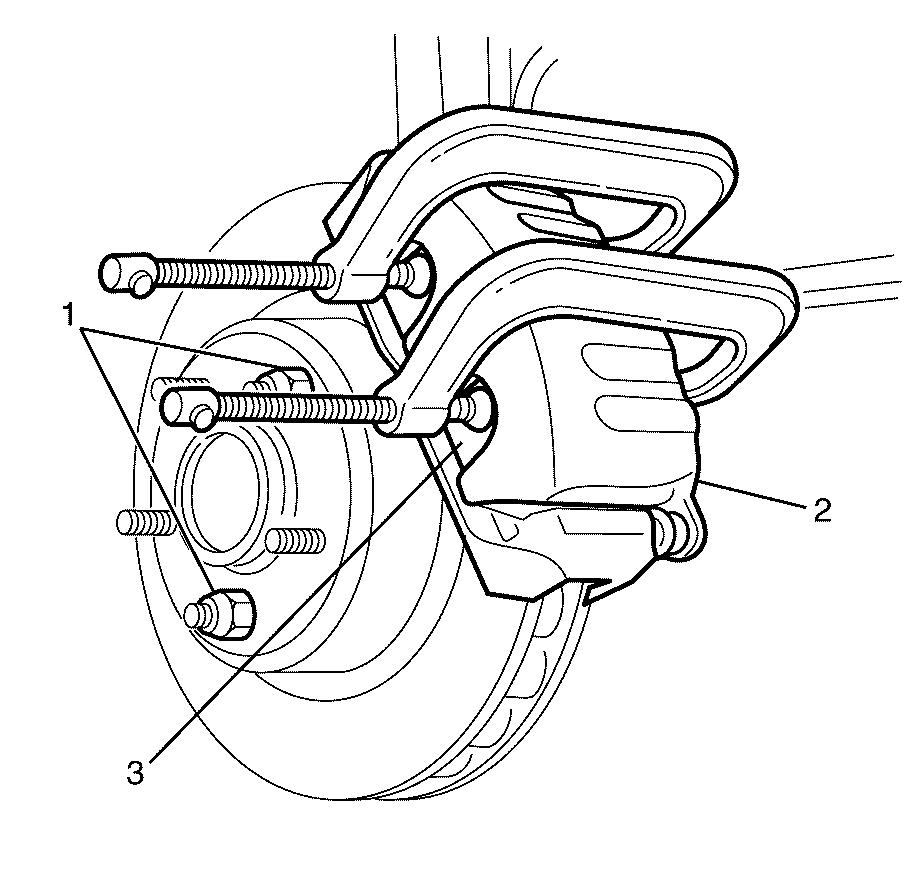
- Install 2 opposite wheel nuts (1),
with the flat side of the wheel nut against the brake rotor to retain the brake rotor
to the wheel hub.
Note: Position the ends of the G-clamps against the rear
of the brake caliper (2) and against the outboard brake pad (3).
- Install a large G-clamp over the body of the brake caliper (2).
Note: The brake caliper piston should slide smoothly into
the brake caliper bore. Overhaul or replace the brake caliper assembly if the brake
caliper piston is frozen or the brake caliper piston does not bottom out smoothly.
- Tighten the G-clamps until the brake caliper pistons bottom out in the
brake caliper bores.
- Remove the G-clamps from the brake caliper (2).
Note: Minimal freeplay should exist between the brake caliper (2)
and the anchor bracket. If too much free play exists, the brake caliper guide pins
and anchor bracket requires further inspection.
- Grasp the brake caliper (2) and move the brake caliper (2) up
and down.
Note: The brake caliper (2) should slide smoothly
along the brake caliper guide pins with minimal force. If the movement of the brake
caliper (2) along the guide pins are not smooth, the brake caliper guide pins
and anchor bracket requires further inspection.
- Grasp the brake caliper (2) and move the brake caliper (2) in
and out along the brake caliper guide pins.
Note: DO NOT disconnect the hydraulic brake flexible hose
from the brake caliper. Failure to comply will require that the brake system be bleed.
- Remove the brake caliper. Refer to
Front Brake Caliper Replacement.
Notice: Support the brake caliper with heavy mechanic wire, or equivalent,
whenever it is separated from its mount and the hydraulic flexible brake hose is still connected. Failure to support the caliper in this manner will cause the flexible brake hose to bear the weight of the caliper, which may cause damage to the brake hose and
in turn may cause a brake fluid leak.
- Inspect the brake caliper to steering knuckle retaining bolts for the following:
| • | Bent or damaged brake caliper to steering knuckle retaining bolts. |
| • | Seizing in the knuckle. |
- If any of the conditions listed are found, replace the brake caliper to
steering knuckle retaining bolts.
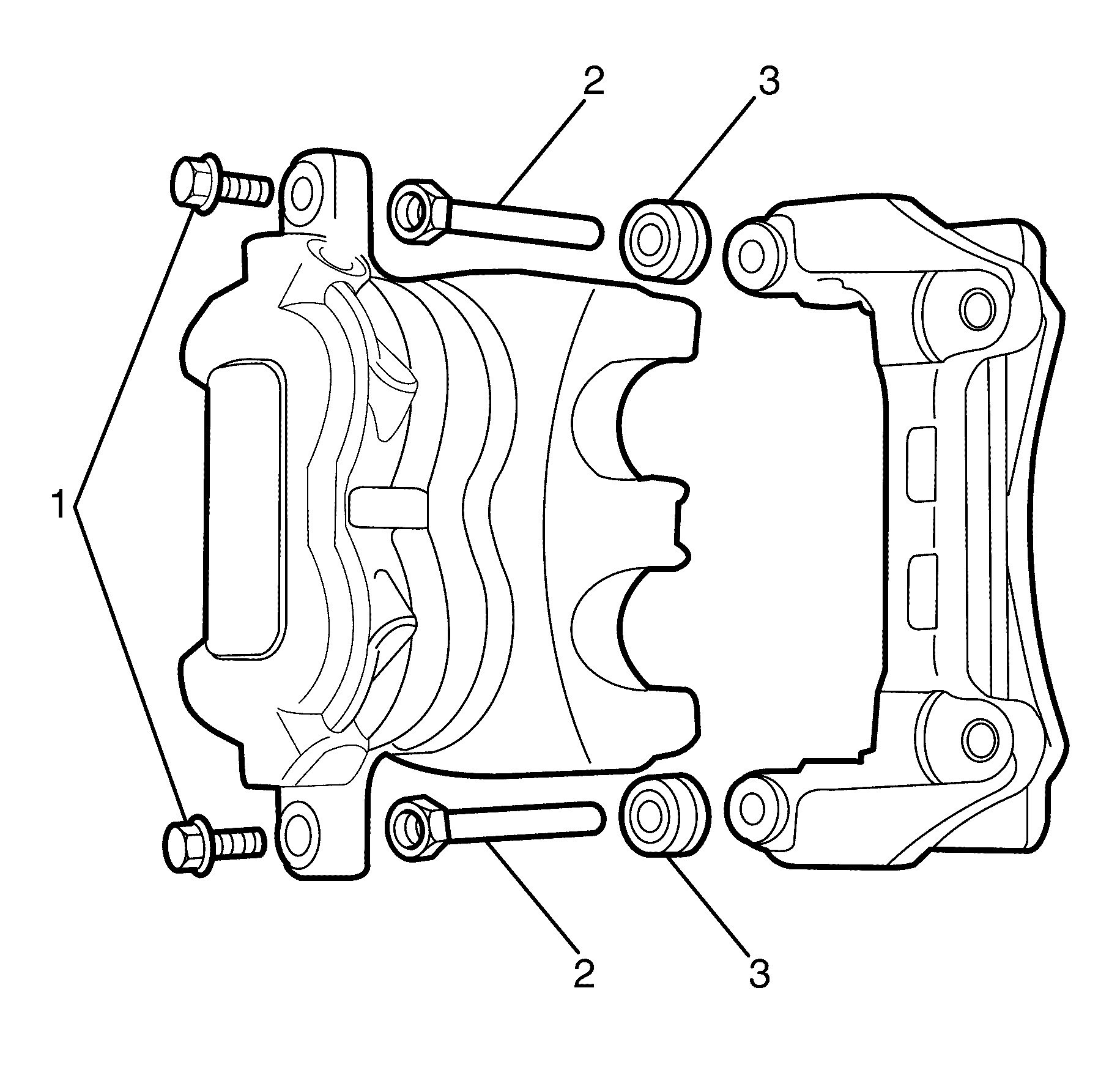
- Remove the brake caliper lower guide pin
retaining bolts (1) and inspect for the following:
- If any of the above conditions are found, replace the brake caliper lower
guide pin retaining bolts (1)
Note: Do not disengaging the guide pins from the brake caliper
boots (3) at this stage.
- Gently slide the brake caliper guide pins (2) in and out of the anchor
bracket and inspect brake caliper guide pins (2) for the following:
- If any of the conditions listed above are found, replace the brake caliper
guide pins (2).
- Inspect the brake caliper boots (3) for the following:
| • | Missing brake caliper boots. |
| • | Cracked or torn brake caliper boots. |
| • | Deteriorated brake caliper boots |
- If any of the conditions listed above are found, replace the brake caliper
boots (3).
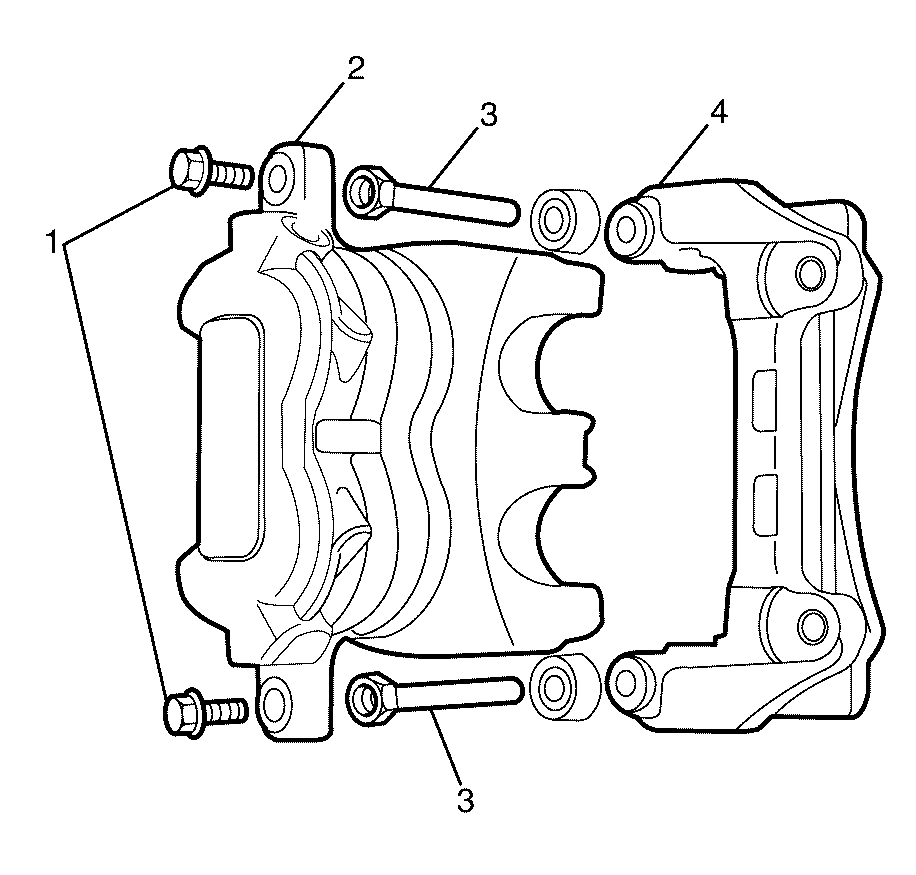
- Inspect the brake caliper (2) and
brake caliper anchor plate (4) for the following:
| • | Bent or damaged brake caliper anchor plate (4). |
| • | Excessive play between the brake caliper guide pins (3) and the
brake caliper anchor plate (4). |
| • | Excessive play between the brake caliper guide pin bolts (1) and
the brake caliper (2). |
- If any of the conditions listed above are found, replace or overhaul the
brake caliper assembly.
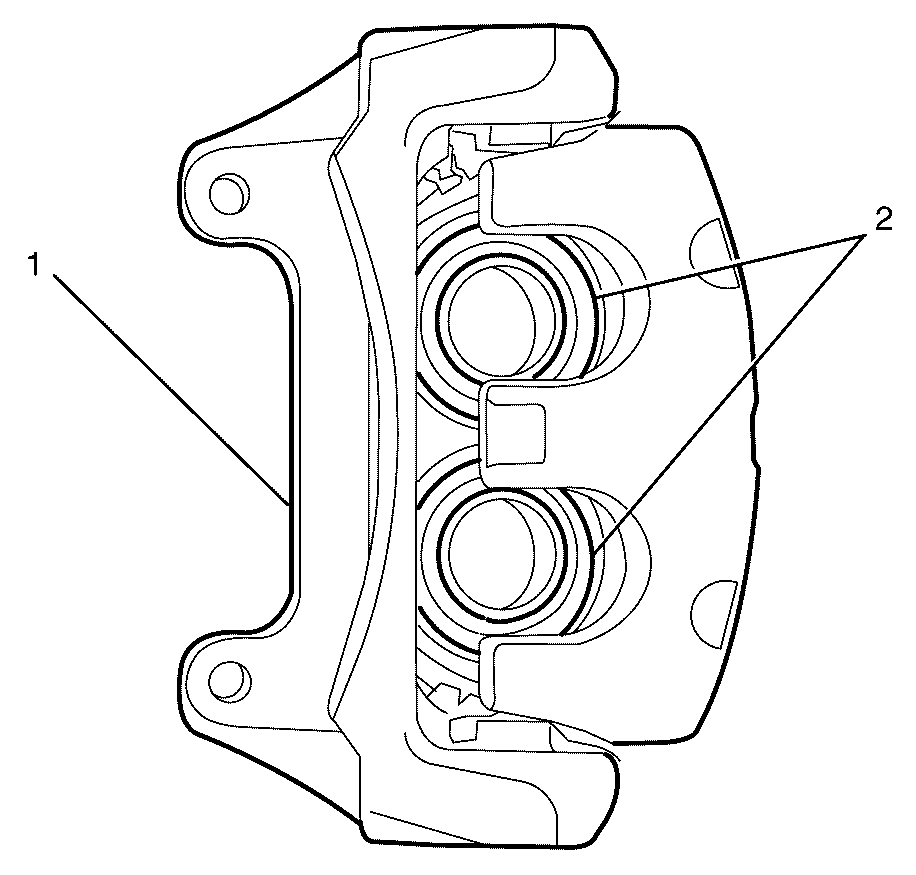
- Inspect the brake caliper piston dust boot
seals (2) for the following:
| • | incorrect seating of the brake caliper piston dust boot seals (2)
in the brake caliper (1) |
| • | brake fluid leakage around the brake caliper piston dust boot seals (2) |
- If any of the conditions listed above are found, replace or overhaul the
brake caliper assembly.







